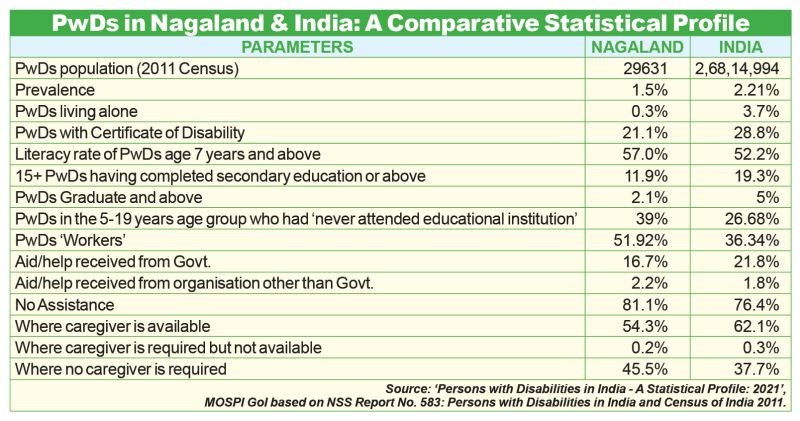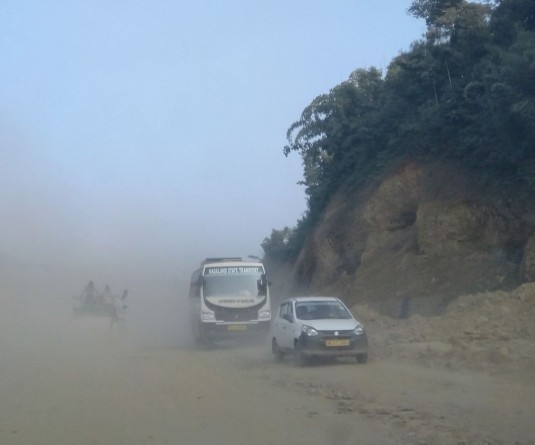
Morung Express News
Dimapur | April 14
The latest statistical report compiled by a central ministry, among others, has revealed two contrasting status of the Persons with Disabilities (PwDs) in Nagaland.
On the positive side, corresponding with their total population, Nagaland had the highest share of PwDs designated as ‘workers’ in India at 51.92%.
Sikkim (49.04%) and Arunachal Pradesh (44.69%) were placed second and third highest respectively while it was lowest in Lakshadweep (19.88%), followed by Kerala (23.59%) and NCT of Delhi (27.92%). Overall, 36.34% of the total PwDs in India were designated as ‘workers
The report, ‘Persons with Disabilities (Divyangjan) in India - A Statistical Profile: 2021’ was released by the Union Ministry of Statistics and Programme Implementation (MOSPI) on March 31. It was based on the 2011 Census and the National Sample Survey (NSS) 76th Round Surveys on Disability (July- December 2018).
However, as unpaid household members who assisted in the operation of an economic activity in the household farm or non-farm activities are also considered as ‘workers,’ in the NSS, the data should be interpreted accordingly.
On the other hand, the report also highlighted that Nagaland had the highest share of PwDs in the 5-19 years category who had ‘never attended educational institution’ at 39% (38.88%), followed closely by Assam at 35%. The national average was 26.68%.
Meanwhile, the rate of PwDs presently attending educational institution was highest in Goa & Kerala (73%) followed by Maharashtra and Lakshadweep (70%).
Overall profile
According to MOSPI, the latest publication (after a similar profile in 2016) is an attempt to depict a “situational analysis of disabled persons in India.” Besides statistics on PwDs status at national and State/UTs level, it is also aimed at sensitizing on the data requirements emerging from the recent international commitments, it added.
The report put the number of PwDs population in Nagaland at 29631 as against 2, 68,14,994 in India, denoting a prevalence rate of 1.5% and 2.2% respectively.
Among the States/Union Territories (UTs), Sikkim had the highest prevalence at 2.98% while it was lowest in Daman & Diu (0.9%).
A total of 21.1% PwDs had ‘Certificate of Disability’ in Nagaland against the all-India average of 28.8%.
Concern areas
Despite having the highest participation in economic activity, access to education for PwDs in Nagaland was a big concern area highlighted by the report.
Apart from highest percentage in ‘never attended educational institution’ parameter, the literacy rate among the PwDs in Nagaland was just 43.54% as against State’s overall rate of 79.55% as per the 2011 Census.
Going upward, PwDs aged 15 and above having completed secondary education or above was just 11.9% in Nagaland against all-India average of 19.3%.
Further, only 2.1% of the PwDs in Nagaland were ‘Graduate and Above’ as against the national average of 5%.
“For empowerment of the disabled population, the attainment of education and participation in economic activity are extremely important,” the report noted.
However, literacy rate of PwDs 7 years and above was higher in Nagaland at 57.0% against national average of 52.2%.
Another concern area was the assistance provided to the PwDs.
The report said that only 16.7% of the PwDs in Nagaland were in receipt of any ‘aid/help from the Government while 2.2% were getting assistance from other sources.
This indicated that over 81.1% of them were not receiving assistance from any source.
Incidentally, in Nagaland, the report depicted that assistance to PwDs was higher in rural areas than in urban areas at 22.2 % and 10.8% respectively.
Overall, 21.8% of PwDs in India were receiving assistance via government while it was 1.8% from other sources. 76.4% of PwDs were not receiving any aid.
On a positive note, the report said that only 0.3% of PwDs in Nagaland were living alone against the all-India average 3.7%, while nearly half of PwDs (45.5%) in the State were not in need of caregiver.






